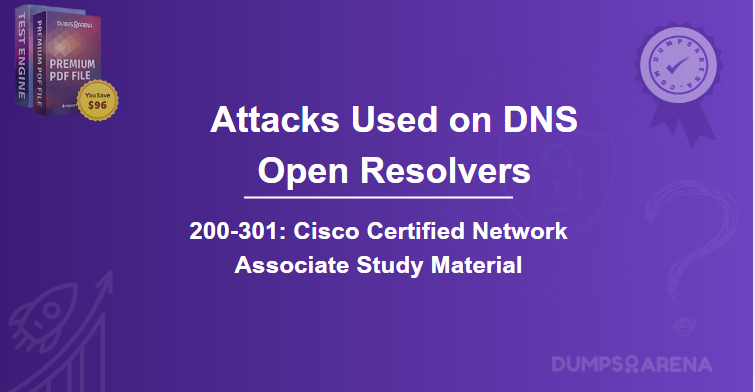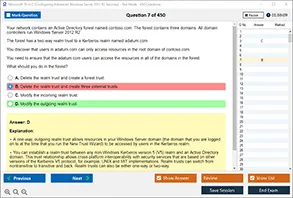Introduction
The Domain Name System (DNS) is a critical component of the internet, translating human-readable domain names into machine-readable IP addresses. However, DNS open resolvers—publicly accessible DNS servers that respond to queries from any user—are often exploited by attackers to launch large-scale cyberattacks. Understanding these attacks is crucial for network security professionals, especially those preparing for the Cisco 200-301 CCNA exam, which covers DNS security extensively.
This article explores two primary types of attacks used on DNS open resolvers, their impact on networks, and their relevance to the Cisco 200-301 certification. Additionally, we will discuss how DumpsArena, a leading platform for IT certification exam preparation, provides valuable resources to help candidates master these concepts efficiently.
1. DNS Amplification Attacks
How DNS Amplification Attacks Work?
A DNS amplification attack is a type of Distributed Denial-of-Service (DDoS) attack where an attacker exploits open DNS resolvers to overwhelm a target with massive amounts of traffic. The attack follows these steps:
- Spoofed Queries – The attacker sends small DNS queries to multiple open resolvers, forging the source IP address to match the victim’s IP.
- Amplified Responses – The DNS resolvers respond to the spoofed queries with much larger responses, often 10x to 100x the size of the original request.
- Traffic Overload – The victim’s server is flooded with amplified DNS responses, causing bandwidth exhaustion and service disruption.
Why DNS Open Resolvers Are Vulnerable?
- No IP Validation – Open resolvers do not verify the source IP, allowing spoofing.
- Large Response Payloads – DNS responses (especially those using ANY or TXT records) can be significantly larger than queries.
- Botnet Utilization – Attackers use botnets to send millions of spoofed queries, multiplying the attack’s impact.
Mitigation Techniques
- Rate Limiting – Restricting the number of responses per IP.
- Disabling Recursion – Preventing open resolvers from responding to external recursive queries.
- Implementing Response Rate Limiting (RRL) – Reducing the impact of amplification.
Relevance to Cisco 200-301 Exam
The Cisco 200-301 exam tests candidates on network security fundamentals, including DDoS mitigation strategies. Understanding DNS amplification attacks is essential for:
- Security configurations on Cisco devices.
- Implementing best practices to secure DNS infrastructure.
2. DNS Cache Poisoning (DNS Spoofing)
How DNS Cache Poisoning Works?
DNS cache poisoning (or DNS spoofing) is an attack where malicious actors corrupt the DNS cache of an open resolver, redirecting users to fraudulent websites. The process involves:
- Exploiting Recursive Queries – Attackers send fake DNS responses before the legitimate resolver can reply.
- Injecting False Records – The resolver caches the incorrect IP, associating a legitimate domain with a malicious server.
- Redirecting Traffic – Users requesting the poisoned domain are sent to phishing or malware-infected sites.
Why Open Resolvers Are at Risk?
- Lack of DNSSEC – Without DNS Security Extensions (DNSSEC), resolvers cannot verify response authenticity.
- Predictable Transaction IDs – Older DNS systems use sequential IDs, making spoofing easier.
- High Query Volume – Attackers overwhelm resolvers to increase poisoning success rates.
Mitigation Techniques
- Deploying DNSSEC – Ensures DNS responses are digitally signed and authenticated.
- Randomizing Query IDs – Makes it harder for attackers to predict transaction sequences.
- Restricting Recursive Queries – Limiting recursion to trusted clients only.
Relevance to Cisco 200-301 Exam
The Cisco 200-301 certification emphasizes network security protocols, including:
- DNSSEC implementation for secure DNS resolution.
- Identifying and mitigating spoofing attacks in enterprise networks.
Role of DNS Security in Cisco 200-301 Certification
The Cisco Certified Network Associate (200-301 CCNA) exam validates a candidate’s ability to secure network infrastructure, including DNS-related threats. Key topics include:
- DNS Attack Vectors – Understanding amplification and poisoning attacks.
- Mitigation Strategies – Configuring Cisco devices to prevent DNS exploits.
- DNSSEC & Best Practices – Ensuring DNS integrity and authentication.
Candidates must demonstrate hands-on skills in securing DNS resolvers, making this knowledge critical for exam success.
How DumpsArena Helps in Cisco 200-301 Exam Preparation?
Preparing for the Cisco 200-301 exam requires high-quality study materials and real-world practice scenarios. DumpsArena provides:
- Latest Exam Dumps – Updated questions covering DNS security topics.
- Detailed Explanations – Clear breakdowns of DNS attack mechanisms.
- Practice Tests – Simulating real exam conditions for better preparation.
- Hands-on Labs – Virtual environments to test DNS security configurations.
By using DumpsArena’s resources, candidates can master DNS security concepts and pass the 200-301 exam with confidence.
Conclusion
DNS open resolvers are prime targets for DNS amplification attacks and DNS cache poisoning, both of which can cripple network services. Understanding these threats is essential for Cisco 200-301 certification and real-world network security.
For aspiring CCNA professionals, DumpsArena offers reliable Cisco exam preparation tools, ensuring a deep grasp of DNS security and other critical networking topics. By leveraging these resources, candidates can enhance their knowledge and achieve certification success.
Get Accurate & Authentic 500+ CCNA 200-301 Exam Questions
1. Which of the following are common attacks targeting DNS open resolvers? (Choose two.)
A. Phishing
B. DNS Amplification
C. SQL Injection
D. DNS Cache Poisoning
2. What is the primary goal of a DNS amplification attack?
A. To steal sensitive user data
B. To overwhelm a target with excessive DNS response traffic
C. To modify DNS records permanently
D. To encrypt DNS queries
3. DNS cache poisoning is dangerous because it:
A. Slows down DNS resolution
B. Redirects users to malicious websites by corrupting DNS records
C. Encrypts all DNS traffic
D. Blocks legitimate DNS queries
4. Which attack exploits open DNS resolvers to generate large responses to small queries?
A. Man-in-the-Middle (MitM)
B. DNS Amplification
C. Cross-Site Scripting (XSS)
D. Brute Force Attack
5. How does an attacker perform DNS cache poisoning?
A. By flooding the DNS server with requests
B. By injecting false DNS records into the resolver's cache
C. By encrypting DNS queries
D. By physically damaging DNS servers
6. Which of the following best describes an open DNS resolver?
A. A DNS server that only responds to authenticated users
B. A DNS server that accepts queries from any source on the internet
C. A DNS server that blocks recursive queries
D. A DNS server used only for internal networks
7. What is a common mitigation technique against DNS amplification attacks?
A. Disabling recursive queries on open resolvers
B. Encrypting all DNS traffic
C. Increasing DNS cache size
D. Blocking UDP traffic completely
8. Which protocol is typically abused in DNS amplification attacks?
A. TCP
B. HTTP
C. UDP
D. FTP
9. What makes DNS open resolvers vulnerable to attacks?
A. They require authentication for all queries
B. They respond to recursive queries from any IP address
C. They only use encrypted connections
D. They are physically secured in data centers
10. Which of these attacks could lead to users being redirected to fake websites?
A. DNS Amplification
B. DNS Cache Poisoning
C. Denial-of-Service (DoS)
D. Port Scanning



